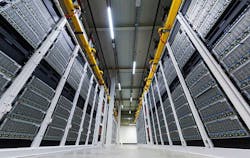Microsoft Aims to Slash Data Center Water Usage by 95 Percent in 3 Years
Microsoft says it will reduce the use of water in its data centers by 95 percent by 2024, as it refines how it designs and operates its massive cloud infrastructure.
The company plans to operate its data centers at warmer temperatures, enabling it to dramatically reduce its water use and environmental impact. Microsoft also plans to boost its use of liquid immersion cooling as it optimizes its cloud infrastructure to meet its commitment to be carbon-negative by 2030.
“Data centers must be part of the solution for broad decarbonization,” said Noelle Walsh, Corporate VP of Cloud Operations and innovation for Microsoft, said in a blog post.
Walsh said Microsoft expects to build between 50 and 100 data centers every year as it continues a massive expansion of its cloud infrastructure.
“The increasing demand for cloud leads to increasing demand for data centers, which require power, land and water to operate,” said Walsh. “We – and the cloud industry – face an important challenge as a result: scaling our computing power to progress digital economies, research and inclusive economic opportunities – while also helping to preserve the only planet we have.”
Data Center Water Use Draws Scrutiny
The cooling and water use announcements are part of a larger update on Microsoft’s “Path to Net Zero” initiatives for decarbonization, which also included the release of Microsoft Cloud for Sustainability, a cloud service for tracking and reporting corporate emissions.
Companies are facing growing scrutiny about their data center water use as they announce new projects in regions facing severe drought, especially the Phoenix area. Recent media coverage has highlighted the enormous water used by some data center cooling technologies, as well as the efforts by Microsoft, Facebook and other cloud builders to address concerns that their facilities may compete with local residents for access to scarce water resources.
Microsoft intends to build between 50 and 100 data centers every year as it continues a massive expansion of its cloud infrastructure.
Microsoft has pledged to be water-positive as a company by 2030. Data centers will be a focal point for that effort, as they use large volumes of water in their cooling systems.
It says it will seek to reduce its reliance on evaporative cooling, a technique that was widely adopted for its energy efficiency, but can use large amounts of water.
The solution? Run the data center at a warmer temperature, so less cooling is required – which in turn allows the use of approaches that use less water. The key variable is the “set point” – the target temperature at which air is delivered to servers within data center racks.
“Through our extensive global research on server performance in warmer temperatures, we’re able to create higher set points for a variety of different climates for when water-based, evaporative cooling is necessary to preserve server performance and reliability,” said Walsh.
“We expect this project to be fully implemented by 2024, and it has the potential to eliminate water use for cooling in regions like Amsterdam, Dublin, Virginia and Chicago, while reducing water use in desert regions like Arizona by as much as 60 percent,” Walsh added.
A Long Warming Trend
Warmer data centers have been a hot topic for many years. In the early days of the IT industry, data centers often resembled meat lockers due to the belief that cooler temperatures extended the life of servers and storage units.
Microsoft was among the pioneers in dispelling this belief. In 2008, Microsoft’s data center team placed a rack of servers in a tent in their equipment yard for 8 months with no equipment failures. Intel and Google found similar results.
That prompted hyperscale operators to raise the temperature in their server rooms above the standard range of 68 to 72 degrees. Google began operating in the 80s, and Microsoft said it runs data halls in its Dublin facility at up to 95 degrees.
How warm will Microsoft run its data centers? The company isn’t announcing a target range.
“We’re continuing our research to determine what the final set point will be, before additional evaporative cooling is needed to preserve server reliability,” the company said.
Running at higher set points requires precise management of temperature and airflow within the data center. Microsoft and other cloud operators customize their server, rack and data center design to allow high levels of monitoring and feedback. This customization can extend to designs that operate in hotter environments.
In assessing cooling temperatures and reliability, a historic reference point has been recommendations from ASHRAE, the leading industry group for heating and cooling professionals. ASHRAE thermal guidelines recommend an upper range of 9o degrees for data center equipment and 104 degrees for telecom gear (category A1), but says some equipment can run at temperatures as high as 113 degrees (category A4). Dell certifies some of its servers to operate at up to 104 degrees F (40 degrees C), for example.
Microsoft said its shift to higher set points will work with both existing equipment and new generations of hardware.
Implications for Industry Best Practices for Cooling
The data center industry will be paying close attention to Microsoft’s effort, hoping for insights that can further advance industry best practices for slashing water usage.
Higher set points present other challenges, including server fan activity. If temperatures get too warm, server fans can kick on, reducing the energy savings. Hyperscale operators like Microsoft can address this with fanless servers due to the uniformity and control of their data hall environments.
Warmer temperatures are difficult in multi-tenant colocation facilities, which feature data halls shared by multiple customers, not all of whom are likely to have the equipment and comfort level for hotter environments.
But Walsh emphasized that a collaborative approach is essential, a position shared by industry groups like Infrastructure Masons. Although data center builders are already the largest adopters of green energy, recent storms and heat waves are prompting a renewed sense of purpose on climate.
“Our sustainability commitments are ambitious but necessary,” said Walsh. “The climate challenges we face won’t be solved by one company or industry alone,” said Walsh. “What’s good for business can also be good for the planet. We know this because it’s something our customers care deeply about.”






